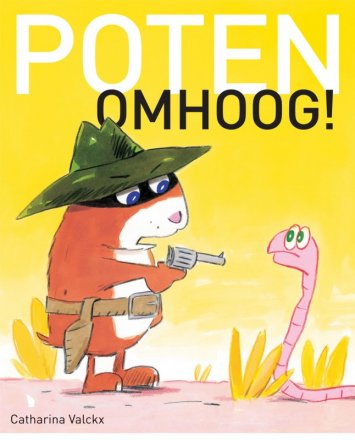Speech
Translation of the speech held at the presentation of the Children’s Bookstore Prize awarded to “Paws up!”
18 November 2011 , Amsterdam
The jury has asked me to share something about myself and my work.
I’ll start with my childhood. I am the second in a family of five daughters. My parents moved to France when I was two years old because of my father’s work; he did research on elementary particles. So we lived in a pretty backward village close to Paris. In the middle of nowhere. We had a large garden on the edge of a wood. There were many children in the area who were kept on a short leash (and even beaten), but in our house we had a lot of freedom. My mother was quite unconventional, artistic and very hospitable. The kids found their way to our garden quite rapidly.
So on one hand, there was great freedom in our home, and on the other hand there was the school: the incredibly strict French education that we went through in that village and later at the girls’ grammar school in Versailles. Fear was the main pedagogic instrument that was used, frequent punishments (even corporal) and verbal humiliations were the order of the day.
The outcome of these fairly traumatic experiences at school was that I became shy – and my sisters too. And that resulted in my starting to draw and write – as a means of demonstrating who you are, but in a safe, controlled way.
It was quite late when I began to produce children’s books. The first was published when I was 40. Before that, I worked as a so-called “artist”. A painter. After I finished my schooling in France, I went to art school in Groningen and later on, I did the postgraduate Studio ’63 training.
I had always written a lot but for my own pleasure. Especially in French because I missed using that language. I mostly wrote fiction. Even while writing this speech, I find it hard to stick to the truth, if I can’t fantasize, I find it pretty dull.
When I started on my first book for children, it was only logical that I should also write the story. I’ve always seen the picturebook as an entity: the story and the pictures. As I write, I see the pictures before me like a film. And of course I write about the things I enjoy drawing.
The illustrations have a clear function. I’m not out to produce works of art as I did earlier, but a picture that makes the story come alive. But if I think the color isn’t right, I’ll do it over and over again until I’m satisfied with it. Once a painter, always a painter.
Of course, my main goal is that children get a lot of pleasure from my books – that’s most important – but as my picture books are designed for children who cannot yet read, they also have to be enjoyable for the one who reads for the child. It’s a wonderful challenge to make a book that makes a child enthusiastic as well as an adult.
By the way, that is precisely why I started this work. I got an enormous kick out of reading books to my son that we both really enjoyed. Those were moments of great joy. For example, reading Little Bear by Else Minarik, illustrated by Sendak. Or the stories about Frog and Toad by Lobel (in fact everything by Lobel), or books by Janosch, Astrid Lindgren, Jean Dulieu (Dutch underestimated writer/illustrator). These are just a few; there are many others of course, the list is long, but these were quite important.
So my goal is that the children and the parents enjoy my stories and get a good laugh out of them. I somehow think that humor is a major value in creativity. I especially love humor that is absurd: crooked logic that somehow still seems logical, or crazy scenes, funny dialogues.
As an infant, you learn how the world turns: how you should behave, how you should talk and how you should think. What I want to do is open a window. Look here, it's a bit odd may be, but it’s also nice. On the other hand, I believe that my books also contain a kind of unspoken moral (but they are never moralistic!). People often tell me that my characters are so kind, so altruistic. Kindness is an underestimated quality nowadays. Kind has nothing to do with sugary or sticky. What I love the most is kindness en humor associated (you may wake me up in the middle of the night for that!)
I was 18 in 1975, and I became “impregnated” with hippie ideals which I have never lost. I believe the peace and love content of my books is fairly high. My naïve ideal is still that everyone could love each other (but I lost my illusions, of course). I try to make a kind of “feel good” books. Maybe because, for me as a child, the world didn't seem such an easy place, it was even frightening sometimes. And sometimes it still is.
I am reluctant to saddle young infants with a very sad story. I won’t bother them with ecological problems, injustice or poverty. I feel that they first need to learn to love the world, the people, the animals and plants, and be able to believe that they are not the only ones who do that.
But that is theorizing in hindsight, because when I think up a story or choose a particular theme for the story, for a picture, it’s mostly intuitively.
